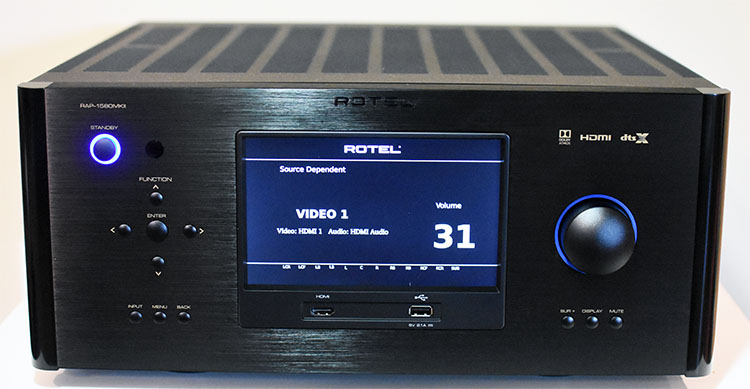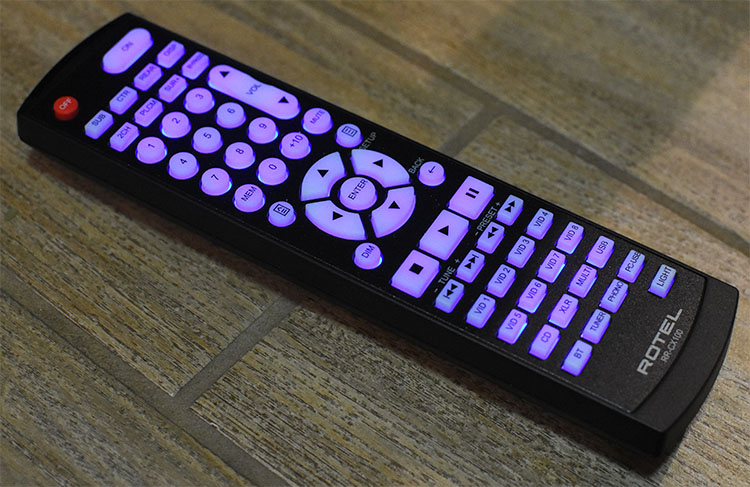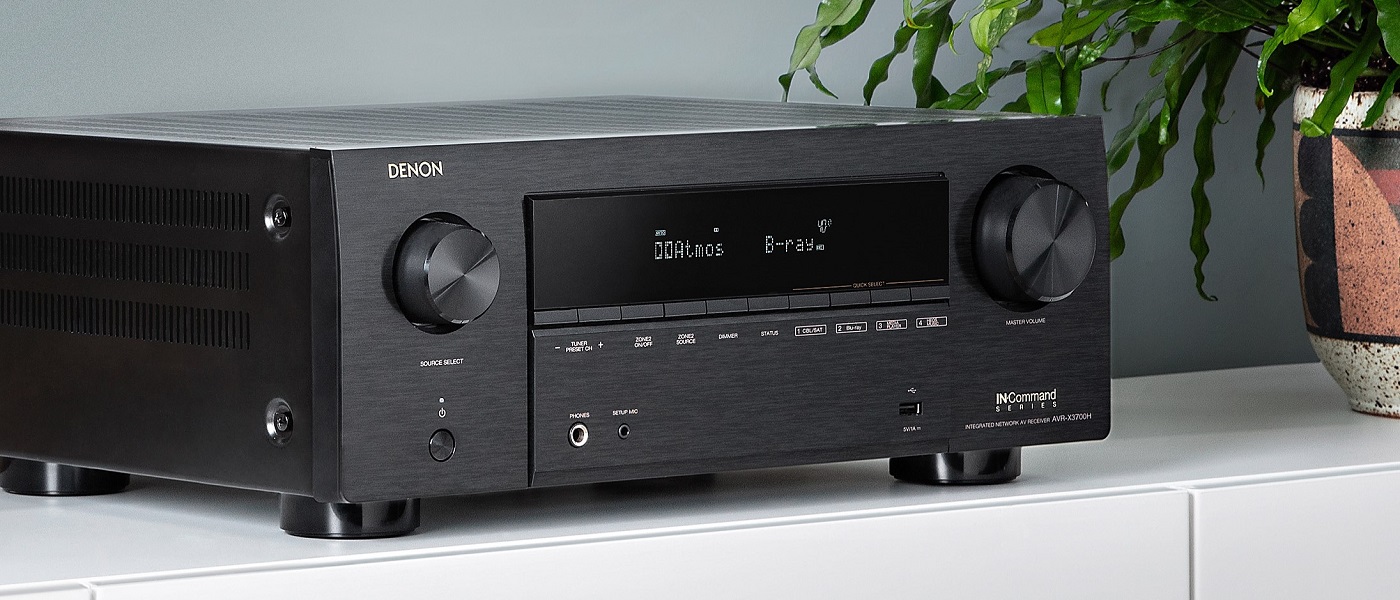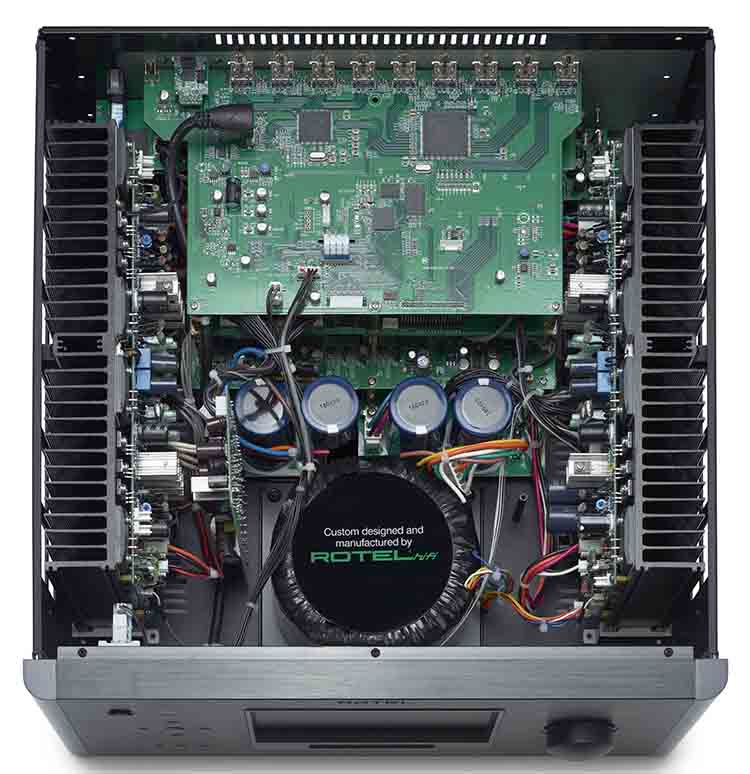
The RAP-1580MKII is capable of processing 7.1.4 Dolby Atmos and DTS:X surround formats and is equipped with an onboard integrated 7-channel Class AB amplifier of 100 Watts output power into 8-ohm loads (140 Watts into 4-ohm loads). It also comes with a USB measurement microphone for Dirac Live LE room correction technology, a feature that is intended to optimize performance in any setting. The RAP-1580MKII includes a vast array of audio inputs including analog (single-ended and balanced), HDMI with support for 4K video with HDCP 2.2 HDR digital, coax and optical digital, PC-USB with 24-bit/192-kHz processing capability, apt-X wireless Bluetooth, Moving Magnet Phono stage, and front panel iOS USB. The digital to analog conversion is handled by an array of 6 Wolfson 24-bit/192kHz DAC chips. A large front panel display provides easy adjustments of all configuration parameters.

Rotel RAP-1580MKII Surround Amplified Processor
- Solid build quality and finish.
- 7.1.4 Dolby Atmos and DTS:X surround processing capability.
- 4K HDMI pass-through feature with HDCP 2.2 support.
- Dirac Live LE room correction feature.
- 6 Wolfson 24-bit/192kHz DAC chips.
- 7 x 100 W onboard amplifier (FTC).
The Rotel RAP-1580MKII is a home-theater processor with 7-channels of onboard amplification. As an integrated amplifier in a stereo music system, the RAP-1580MKII offers a single-box solution for home-theater processing. For people who are strapped on component space, this is a make-sense solution. In a way, it is similar to what an AV receiver offers, but if you are like me, then the radio tuner part in the AV receiver is actually an unnecessary feature since I never listen to AM/FM radio through my home-theater system. In such a situation, a surround amplified processor like the RAP-1580MKII can be a more appealing solution.
Secrets Sponsor
The RAP-1580MKII is the only surround amplified processor in the Rotel product lineup and carries a price tag of $4999. Clearly, Rotel created this product to compete in the high-end surround-processing component market segment. Considering that there are many AV receivers to choose from in the low to mid-price categories, I think this is a good strategy. Does the RAP-1580MKII have what it takes to be competitive in the high-end market segment? My review below will shed some light on this aspect.
Audio:
Class AB amplifier
Continuous Power Output:
1k Hz, THD < 0.05%, 4 ohms:
200 watts / channel (2 channels driven)
140 watts / channel (7 channels driven)
1k Hz, THD < 0.05%, 8 ohms:
135 watts / channel (2 channels driven)
20 – 20k Hz, THD < 0.05%, 8 ohms:
100 watts / channel (7 channels driven)
Intermodulation Distortion (60 Hz : 7 kHz, 4:1): < 0.05% Frequency Response:
Phono Input:
20 Hz – 20k Hz, ± 1 dB
Analog Bypass:
10 Hz – 100k Hz, ± 1 dB
Digital Input:
20 Hz – 20k Hz, ± 0.5 dB
Damping Factor (1k Hz, 8 ohms): 230
Signal to Noise Ratio (A-weighted)
Analog Bypass:
100 dB
Digital Input:
96 dB
Input Sensitivity/Impedance:
Phono Level:
3.85 mV / 47k ohms
Line Level:
300 mV / 100k ohms
Balance Level:
600 mV / 100k ohms
Preamp Output Level: 1.2 V
Digital Audio:
LPCM (up to 192kHz, 24-bit), Dolby® Surround, Dolby® TrueHD, Dolby® Atmos, DTS-HD Master Audio, DTS:X, Dirac Live LE
Video
Input Resolutions:
480i/576i, 480p/576p, 720p, 1080i, 1080p, 1080p 24Hz, 3D, 4K, UHD
Output Resolution:
480i/576i, 480p/576p, 720p 1080i, 1080p, 1080p 24Hz, 3D, 4K, UHD
Color Space Support:
sRGB, YCbCr 4:2:2, YCbCr 4:4:4
Deep Color Support:
24-bit, 30-bit, 36-bit
HDMI Inputs/Outputs:
8 inputs with 3 supporting HDCP 2.2
2 outputs supporting HDCP 2.2
Audio Return Channel
General
Power Consumption:
1100 watts
Standby Power Consumption:
< 0.5 watt (standby)
Dimensions:
17″ (W) x 18.5″ (D) x 7.55″ (H)
Weight:
50.27 lbs
MSRP:
$ 4,999 each
Website:
Company Directory:
SECRETS Tags:
rotel, av, processor, receiver, 7 channel, reciever and processor reviews, review 2021
The Rotel RAP-1580MKII sports a look that reflects quality and robust engineering. Lifting it, I could feel its solid construction and significant weight. It is not terribly heavy at about 50 lbs, but it does beat most similarly sized AV receivers out there in the weight department. A quick peek inside reveals the obvious contributors to its weight: a massive custom toroidal transformer in the middle and two large metal heatsinks towards the side of the unit. The RAP-1580MKII looks very well constructed using good quality components all around. The review sample comes in a black finish, but a silver finish option is also available.
The front panel of the RAP-1580MKII looks clean and uncluttered. Besides the on/off button, volume-control rotary knob, USB and HDMI connectors, and some other control buttons, the main feature occupying the front panel’s landscape is the relatively large (7” diagonal) graphics display. When the unit is turned on, this display shows its operational status (input selected, surround mode, volume level, and active channels). In the setup mode, the display shows the whole setup menu, which is extremely useful for configuring the unit or adjusting its settings without relying on an external monitor. This front-panel display is dimmable and can be completely turned off too. I found the information shown on the display to be sufficient, not too much or too little, and nicely laid out. The important information such as the input selected, the volume level, as well as the program material’s surround format is shown in good-sized digits that can be conveniently read from typical seating distances.

Typical to the modern AV surround processing unit, the rear panel of the RAP-1580MKII sports nicely grouped and laid out input/output connectors, including HDMI inputs (7)/outputs (2), digital inputs (coaxial, optical, and USB), analog stereo (including Moving-Magnet (MM) phono and a pair of XLR) and multi-channel inputs, line-level pre-outs (11.2 channels with the provision for 2 center channel pre-outs), and 7 pairs of speaker outputs. The RAP-1580MKII is equipped with a beefy 7-channel Class AB onboard amplifier, capable of delivering 100 W per channel into 8-ohm loads or 140 W per channel into 4-ohm loads with all channels driven. The main power switch, Bluetooth (with aptX) antenna, ethernet port, and DC triggers can also be found on the rear panel. The ethernet port here is not for network streaming playback, but rather for software updates and calibration setup. Most modern AV processors/receivers include a networking feature, and I think Rotel should consider adding this feature in the future iteration of the product to really keep up with the market demand.
The HDMI input connections in the RAP-1580MKII support 3D video with up to 4K resolution. Out of the 8 HDMI inputs (1 is on the front panel), three of them support HDCP 2.2. The two HDMI outputs support HDCP 2.2 but only one of them is ARC enabled and carries the On-Screen Display (OSD) feature. The RAP-1580MKII does not perform any video processing (upscaling, etc.), it only passes them through. The principle that Rotel adopts for the RAP-1580MKII is to just do what it does best, which is the audio processing, and let the video signals be processed by another component in the video chain that is specialized to do such a job. This way, there is no redundant processing of video signals that may unnecessarily degrade the video quality.
The RAP-1580MKII is equipped with six Wolfson 24-bit/192-kHz DAC chips for its digital audio signal processing, which includes PCM audio signals up to 24-bit/192-kHz, Dolby Surround, Dolby® TrueHD, Dolby® Atmos, DTS-HD Master Audio, and DTS:X. Missing here is the support for DSD audio signals, which I think would make the RAP-1580MKII a true centerpiece for multi-channel audio processing in an entertainment system.

The infra-red remote control supplied with the RAP-1580MKII is medium in size with nicely laid-out blue-backlit buttons. Although a bit bulky and heavy, this remote sits nicely in the hand and is comfortable to use. It can be used to access the setup menu and all the functions of the processor. The processor was quite responsive to the remote commands given from straight ahead in front of it, but it seemed to lose this responsiveness when the remote commands were given from larger than about 30 degrees off-axis. Despite this rather narrow remote-command capture-angle, in general, the remote operation of the processor was fairly good for everyday use.

For this review, I used the onboard amplifier of the RAP-1580MKII to drive a 7-speaker configuration: 3 front speakers (Revel Ultima Studio front left/right and Revel C50 center channel) and two pairs of surround speakers (Revel M8 side and NHT Absolute Wall back). Two powered subwoofers (Velodyne DD12 and Paradigm Defiance X12) were connected to the two subwoofer line outputs of the processor to round out a 7.2 surround configuration. If desired, an external amplifier could be used to drive two pairs of additional speakers as the RAP-1580MKII provides the pre-outs to accommodate a full Dolby Atmos 11.2 speaker setup.
Setting up the RAP-1580MKII just to get it up and running was relatively straightforward. It was no more or less than the effort needed to start up an AV receiver. The audio calibration can be done in two ways: manually using an SPL meter (not supplied) or in a more automated fashion using the Dirac Live LE feature. Rotel supplies the microphone to be used with the Dirac Live LE feature, but you will still need to download the Dirac Live application app yourself to the computer/laptop to be used in the calibration. Dirac Live LE is similar to Audyssey calibration and optimization technology, found in many surround processors/receivers, but its calibration process feels slightly more involved as it offers more customizable adjustments. I found, however, that its default adjustment settings were satisfactory and did not feel the need to invoke further customization. Note that the Dirac Live LE license included with the RAP-1580MKII only supports correction in the 30 – 500Hz frequency range. If desirable, customers can purchase an upgrade to the full 20Hz – 20kHz Dirac Live version for $99 directly from Dirac.
At first, I only calibrated the RAP-1580MKII using an SPL meter and I achieved a quite satisfactory surround performance. However, as good as the results using the manual calibration were, they could not beat the results obtained by applying the Dirac Live LE optimization, which really elevated the surround performance of the RAP-1580MKII by a level or two. Smoother surround envelopment, as well as better bass response, were some of the noticeable improvements after the application of the Dirac Live LE. Therefore, I applied the Dirac Live LE calibration result to the surround settings of the RAP-1580MKII throughout my evaluation of the unit.
Operation-wise, although the RAP-1580MKII was quite intuitive to use and trouble-free, it was not without some quirks. I found that occasionally, the default surround mode assigned to a particular input during the setup somehow got overridden to something else. This required me to go back to the setup menu and redo the playback-mode assignment. Also, sometimes it did not lock in immediately to the signals during digital music playback, causing a second or two cut out of the beginning of the tracks. These quirks, however, are relatively minor and might have something to do with the version of the firmware used during the review (version 5.03). I think they could simply be addressed by a firmware update, which in the case of RAP-1580MKII, could be done easily by customers without requiring shipping the unit back to Rotel or bringing it to a dealership. If the unit is connected to the network, the firmware update can be performed over the internet too.
The HDMI connectivity performance of the RAP-1580MKII worked as advertised, passing through audio-video content as it should be. In passing-through videos, it did its job well in the sense that it did not cause any noticeable video degradation. The HDMI switching control feature worked the way it was intended to be, allowing the processor to be powered on/off in sync with the Xfinity cable box connected to it and to take over the processing of the audio signal from my television.
During the whole evaluation period, I set up the RAP-1580MKII as the sole controller for my audio and video sources. All the video switching and playback of audio and movie soundtracks were done through the RAP-1580MKII. Although the RAP-1580MKII does not offer extensive bells and whistles like most modern AV receivers, it has all the essential audio features. No gimmicky surround modes here as all surround processing is handled using Dolby Atmos and DTS:X audio codecs and their derivatives (whatever algorithms Dolby and DTS use to process non-Dolby Atmos or non-DTS :X surround formats). If Rotel’s goal in developing this product is not on loading it with tons of features, but more on getting the best sonic performance possible, then as my review report below indicates, it achieves this goal quite well.
My first review note on the RAP-1580MKII was impressive surround performance. There was a sense of steadiness and prowess in its surround deliverance. Whether it was live TV or movie program material, the RAP-1580MKII handled them all with finesse and ease, delivering a more involving experience. Surround steering and envelopment seemed to be first-rate.

AVA (2020)
The movie AVA (2020) contains a lot of action sequences with significant sound effects, which were delivered by the RAP-1580MKII in full glory. There seemed to be no ambiguity on which direction a certain sound source came from, giving a sense of accurate surround steering. Dialogue in the middle of these action sequences sounded crisp and clear. The sound of gunshots was impactful and the overhead flying helicopter sounded real. The RAP-1580MKII’s onboard amplifier never seemed to lose steam and had enough headroom to deliver all these demanding soundtracks with full textures and authority.

Unknown (2011)
The RAP-1580MKII also delivered engaging surround effects of the movie Unknown (2011), which contains soft and loud passages, action sequences, ambient sounds, as well as various musical scores. The processor managed to produce immersive car chase scene effects in the movie with a sense of brute force and yet sounded smooth and refined in delivering the various background music in the movie. The sonic immersive experience that the processor delivered during the disco-hall scene in the movie really transported me to the middle of the dancing crowd in a big hall with sounds coming from all around me. The movie also showcased the RAP-1580MKII’s excellent ability in handling the soundtrack dynamics.
That the RAP-1580MKII shone very brightly on its surround performance should be clear from my description above. But the processor’s excellence did not stop there. While most other AV receivers or surround processors could comfortably generate good surround effects for movies, they usually struggle in stereo or even surround music reproduction. But not the RAP-1580MKII. This is where this product differentiates itself from the rest of the pack. While its surround performance in reproducing movie soundtracks is nothing short of excellent, it can serve also as a bonafide stereo music playback component that can handle digital or analog music signals equally well.
The DACs in the RAP-1580MKII are quite adept in handling digital music input signals as it is in processing movie soundtracks. It lacks the DSD signal processing capability, but it handles PCM signals up to 24-bit/192-kHz with no issue. I used it a lot to process the digital streaming signals from AURALiC ARIES G1 during the review with very good results (using USB and coax connections). Although it did not beat the musicality that I obtained from my usual music DAC (the PS Audio PerfectWave DAC II), nevertheless the RAP-1580MKII produced satisfactory results that could shame many mid-price integrated stereo systems out there. To give you an example, in my system, the RAP-1580MKII delivered a better stereo performance than Rotel’s own A14 (integrated amplifier with onboard DAC, MSRP $1399) that I reviewed not too long ago.

I’m With Her’s, Call My Name (2019)
The musical presentation through the RAP-1580MKII sounded balanced across the audible frequency spectrum with an excellent top-to-bottom neutrality. It was very adept in vocal reproduction, delivering natural sounding and full-bodied vocals. The vocal harmony of the trio I’m With Her from their single Call My Name (2019) was conveyed beautifully through the RAP-1580MKII. The dynamics of the accompanying musical instruments sounded rich and the whole presentation was full of textural details. The bass beat throughout the track sounded tuneful with sufficient kicks.
While the RAP-1580MKII did not present soundstage as wide and deep as a higher-end dedicated music system could, nevertheless its soundstage presentation was quite respectable.
Secrets Sponsor
It is not an overstatement to say that the RAP-1580MKII exhibits an overall strong performance in all of its functions. Even when used with a turntable through its MM phono input, the resulting playback performance was decent. Its convenient features like the wireless Bluetooth playback and headphone feature also performed respectably. A quick comparison with my resident surround processor, the Marantz AV8802 (MSRP $3999), revealed that even though the AV8802 has more features than the RAP-1580MKII, including 4K video upscaling capability, and could produce comparable movie surround performance, its performance as a music DAC or as a stereo music preamplifier, in general, could not hold a candle to the RAP-1580MKII.
The Rotel RAP-1580MKII is a rare surround amplified processor capable of all-around sonic performance, exhibiting prowess in home-theater/surround as well as in stereo music applications.
- Solid build quality
- Great connectivity and sufficient features
- Dolby Atmos and DTS:X surround technology
- Informative front-panel display
- Sufficiently powerful onboard 7-channel amplifier
- Excellent sonic performance in surround and stereo applications
- Elimination of some operational quirks
- Networking feature
The Rotel RAP-1580MKII is a well-designed surround amplified processor that delivers solid performance in surround and stereo music reproductions. Its surround performance, which features Dolby Atmos and DTS:X decoding capability, is first-rate and competitive to the best out there. Moreover, its stereo music performance is way above the average as compared to that of most surround-processing devices out there. The RAP-1580MKII may not be cheap at $4999, but it is justifiable by its solid build quality and by the fact that it can replace 3-4 boxes of audio equipment in your setup due to its multi-function excellence. It is truly a single piece of audio equipment that can serve your home-theater needs well and still competent enough to satisfy serious stereo music aficionados.




